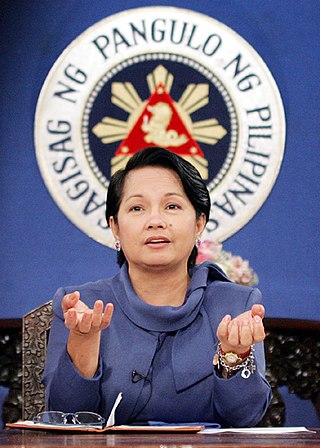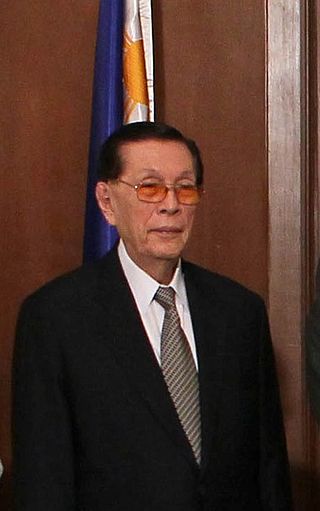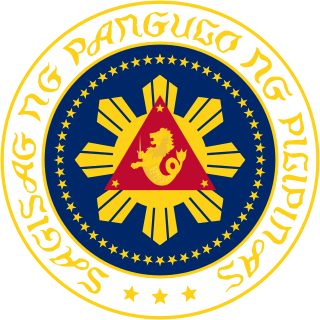Politics in the Philippines are governed by a three-branch system of government. The country is a democracy, with a president who is directly elected by the people and serves as both the head of state and the head of government. The president serves as the leader of the executive branch and is a powerful political figure. A president may only hold office for one six-year term. The bicameral Congress consists of two separate bodies: the Senate, with members elected at-large across the country, and the larger House of Representatives, with members chosen mostly from specific geographic districts. The Congress performs legislative functions. The judiciary is overseen by the Supreme Court of the Philippines and has extensive review jurisdiction over judgments issued by other governmental and administrative institutions.

Maria Gloria Macaraeg Macapagal Arroyo, often referred to by her initials PGMA and GMA, is a Filipino academic and politician who previously served as the 14th president of the Philippines from 2001 to 2010. She was serving in the congress as a Deputy Speaker from 2022 until her removal in November 2023. She is the longest serving president of the Philippines since Ferdinand Marcos. Before her accession to the presidency, she served as the 10th vice president of the Philippines from 1998 to 2001 under President Joseph Estrada, making her the country's first female vice president, despite having run on an opposing ticket. She was also a senator from 1992 to 1998. After her presidency, she was elected as the representative of Pampanga's 2nd district in 2010 and later became the speaker of the House of Representatives from 2018 until her retirement in 2019. She later came out of retirement to be elected as representative of the same district in 2022. She is one of the only 2 Filipinos to hold at least three of the four highest offices in the country: vice president, president, and house speaker, alongside former President Sergio Osmeña.

The president of the Philippines is the head of state, head of government and chief executive of the Philippines. The president leads the executive branch of the Philippine government and is the commander-in-chief of the Armed Forces of the Philippines.

Jaime Lachica Sin, commonly and formally known as Jaime Cardinal Sin, was the 30th Roman Catholic Archbishop of Manila and the third cardinal from the Philippines. He was instrumental in the historic and peaceful 1986 People Power Revolution, which toppled the dictatorship and ended martial law under Ferdinand Marcos and installed Corazon Aquino as his successor in the Fifth Republic of the Philippines. He was also a key figure in the 2001 EDSA Revolution that replaced President Joseph Estrada with Gloria Macapagal Arroyo.

The Second EDSA Revolution, also known as the Second People Power Revolution, EDSA 2001, or EDSA II, was a political protest from January 17–20, 2001 which peacefully overthrew the government of Joseph Estrada, the thirteenth president of the Philippines. Following allegations of corruption against Estrada and his subsequent investigation by Congress, impeachment proceedings against the president were opened on January 16. The decision by several senators not to examine a letter which would purportedly prove Estrada's guilt sparked large protests at the EDSA Shrine in Metro Manila, and calls for Estrada's resignation intensified in the following days, with the Armed Forces withdrawing their support for the president on January 19. On January 20 Estrada resigned and fled Malacañang Palace with his family. He was succeeded by Vice President Gloria Macapagal Arroyo, who had been sworn into the presidency by Chief Justice Hilario Davide Jr. several hours earlier.

The May 1 riots, or EDSA III, were protests sparked by the arrest of newly deposed president Joseph Estrada of the Philippines from April 25 to May 1, 2001. The protest was held for seven days on a major highway in Metro Manila, Epifanio de los Santos Avenue (EDSA), which eventually culminated in an attempt to storm Malacañang.

Juan Valentin Furagganan Ponce Enrile Sr.,, also referred to by his initials JPE, is a Filipino politician and lawyer known for his role in the administration of Philippine president Ferdinand Marcos; his role in the failed coup that helped hasten the 1986 People Power Revolution and the ouster of Marcos; and his tenure in the Philippine legislature in the years after the revolution. Enrile has served four terms in the Senate, in a total of twenty-three years, he holds the third longest-tenure in the history of the upper chamber. In 2022, at the age of 98, he returned to government office as the Chief Presidential Legal Counsel in the administration of Bongbong Marcos.

Francisco "Kit" Sarmiento Tatad is a Filipino journalist and politician best known for having served as Minister of Public Information under President Ferdinand Marcos from 1969 to 1980, and for serving as a Senator of the Philippines from 1992 to 2001.
2006 in the Philippines details events of note that happened in the Philippines in the year 2006.
The Philippines was under a state of emergency, announced by presidential spokesperson Ignacio Bunye on the morning of February 24, 2006, by the virtue of Proclamation No. 1017. This occurred after the government claimed that it foiled an alleged coup d'état attempt against the rule of President Gloria Macapagal Arroyo earlier that same day. State security services also claimed that it had arrested a general who was involved in the coup attempt. President Arroyo lifted the state of emergency on March 3, 2006, by the virtue of Proclamation No. 1021.

Proclamation No. 1081 was the document which contained formal proclamation of martial law in the Philippines by President Ferdinand Marcos, as announced to the public on September 23, 1972.

This article covers the history of the current Philippine republican state following the 1986 People Power Revolution, known as the Fifth Philippine Republic.

Orlando Sanchez Mercado, better known as Orly Mercado, is a Filipino politician and broadcast journalist best known for having served as a senator of the Philippines from 1987 to 1998, Secretary of Defense from 1998 to 2001, and for his long career as a broadcast journalist, most famously for hosting the television program Kapwa Ko Mahal Ko.

Martial law in the Philippines refers to the various historical instances in which the Philippine head of state placed all or part of the country under military control—most prominently during the administration of Ferdinand Marcos, but also during the Philippines' colonial period, during the second world war, and more recently on the island of Mindanao during the administrations of Gloria Macapagal Arroyo and Rodrigo Duterte. The alternative term "martial law era" as applied to the Philippines is typically used to describe the Marcos martial law period specifically.
The national symbols of the Philippines consist of symbols that represent Philippine traditions and ideals and convey the principles of sovereignty and national solidarity of the Filipino people. Some of these symbols namely the national flag, the Great Seal, the coat of arms and the national motto are stated in the Flag and Heraldic Code of the Philippines, which is also known as Republic Act 8491. In the Constitution of the Philippines, the Filipino language is stated as the national language of the Philippines. Aside from those stated symbols in the Constitution and in Republic Act 8491, there are only six official national symbols of the Philippines enacted through law, namely sampaguita as national flower, narra as national tree, the Philippine eagle as national bird, Philippine pearl as national gem, arnis as national martial art and sport and the Filipino Sign Language as the national sign language. Thus, there is a total of twelve official national symbols passed through Philippine laws.

The presidency of Gloria Macapagal Arroyo, also known as the Arroyo administration, spanned nine years from January 20, 2001, to June 30, 2010. She served the remainder of her predecessor Joseph Estrada's term after he was deposed, and she was elected to a full second term in 2004 which ended in 2010. Arroyo is the daughter of 9th president Diosdado Macapagal.

Proclamation No. 55 was signed by Philippine President Rodrigo Duterte on September 4, 2016, to officially declare a state of emergency in the Philippines in response to the 2016 Davao City bombing.
A revolutionary government or provisional government has been declared a number of times in the Philippines, by various insurgent groups.

Early polities in what is now the Philippines were small entities known as barangays, although some larger states were established following the arrival of Hinduism and Islam through regional trade networks. The arrival of Spanish settlers began a period of Spanish expansion which led to the creation of the Captaincy General of the Philippines, governed out of Manila. While technically part of New Spain, the Philippines functioned mostly autonomously. The reliance on native leaders to help govern led to the creation of an elite class known as the principalia. Spanish control was never firmly established over much of its claimed territory, with some inland and Islamic regions remaining effectively independent.














